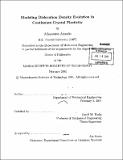Modeling dislocation density evolution in continuum crystal plasticity
Author(s)
Arsenlis, Athanasios, 1975-
DownloadFull printable version (12.40Mb)
Other Contributors
Massachusetts Institute of Technology. Dept. of Mechanical Engineering.
Advisor
David M. Parks.
Terms of use
Metadata
Show full item recordAbstract
Dislocations are the singly most important material defects in crystal plasticity, and although dislocation mechanics has long been understood as the underlying physical basis for continuum crystal plasticity formulations, explicit consideration of crystallo- graphic dislocation mechanics has been largely absent in working constitutive models. In light of recent theoretical developments in dislocation dynamics, and the introduc- tion of geometrically necessary dislocation (GND) density in continuum formulations through plastic strain gradients, a single crystal plasticity model based on dislocation density state variables is developed. The density state variables evolve from initial conditions according to equations based on fundamental concepts in dislocation me- chanics such as the conservation of Burgers vector in multiplication and annihilation processes. Along with those processes that account for bulk statistical dislocation evolution, the evolving polarity due to dislocation species flux divergences may be in- cluded to detail the length-scale dependence of mechanical properties on the micron level. The full dislocation density description of plasticity allows a simple evaluation of the role of GND density in non-homogeneously deforming bodies. A local version of the constitutive model, which captures the bulk processes of dislocation multiplication and annihilation during plastic deformation, is implemented within a finite element framework to investigate the poly-slip behavior of aluminum single crystals under tension. (cont.) A non-local version of the constitutive model using an idealized planar double slip system geometry is implemented within a finite element framework to investigate the length-scale dependence observed in the bending of thin single crystal beams. The results not only capture the mechanical stress/strain response of the material, but also detail the development of underlying dislocation structure responsible_ fr: the plistic behavior of the crystal.
Description
Thesis (Ph.D.)--Massachusetts Institute of Technology, Dept. of Mechanical Engineering, 2001. Includes bibliographical references (p. 221-229).
Date issued
2001Department
Massachusetts Institute of Technology. Department of Mechanical EngineeringPublisher
Massachusetts Institute of Technology
Keywords
Mechanical Engineering.